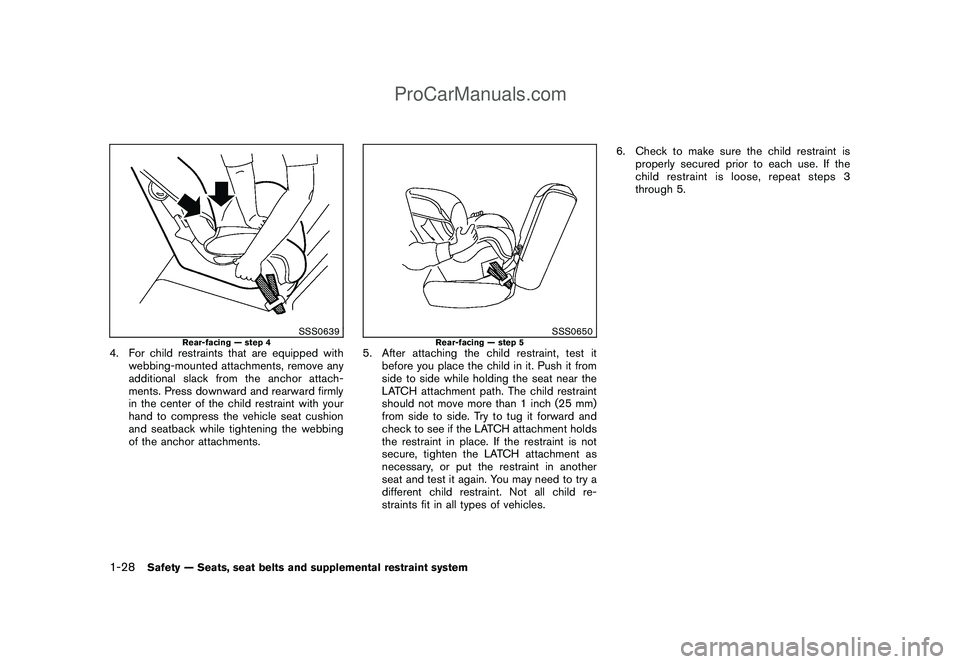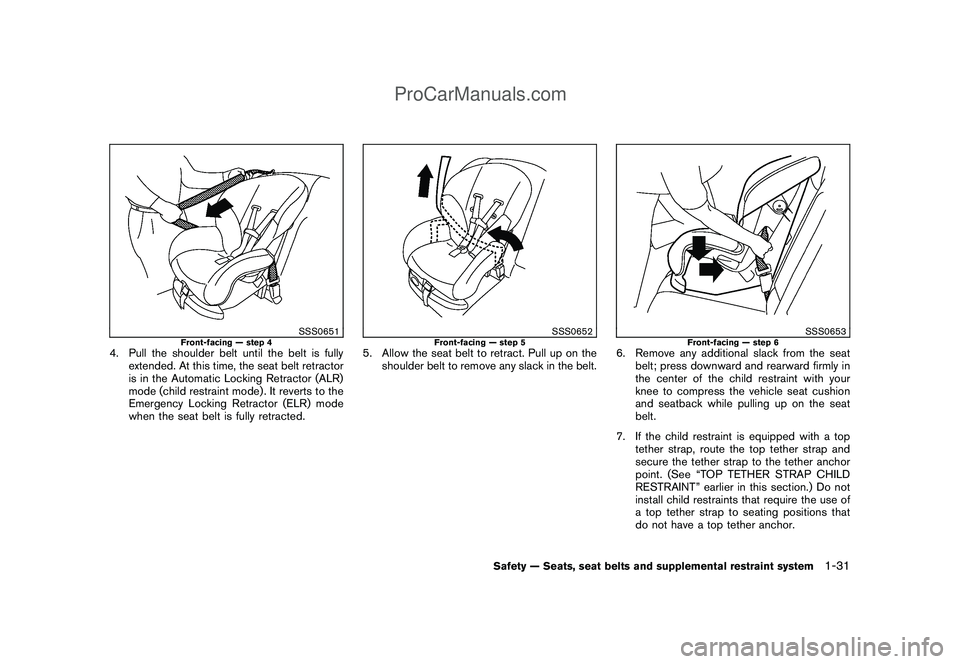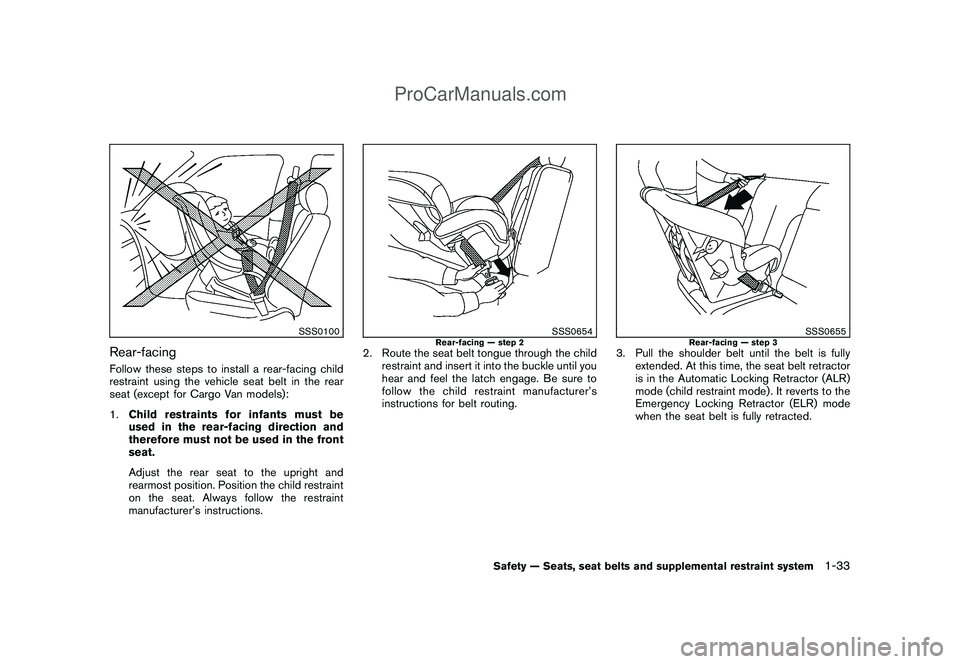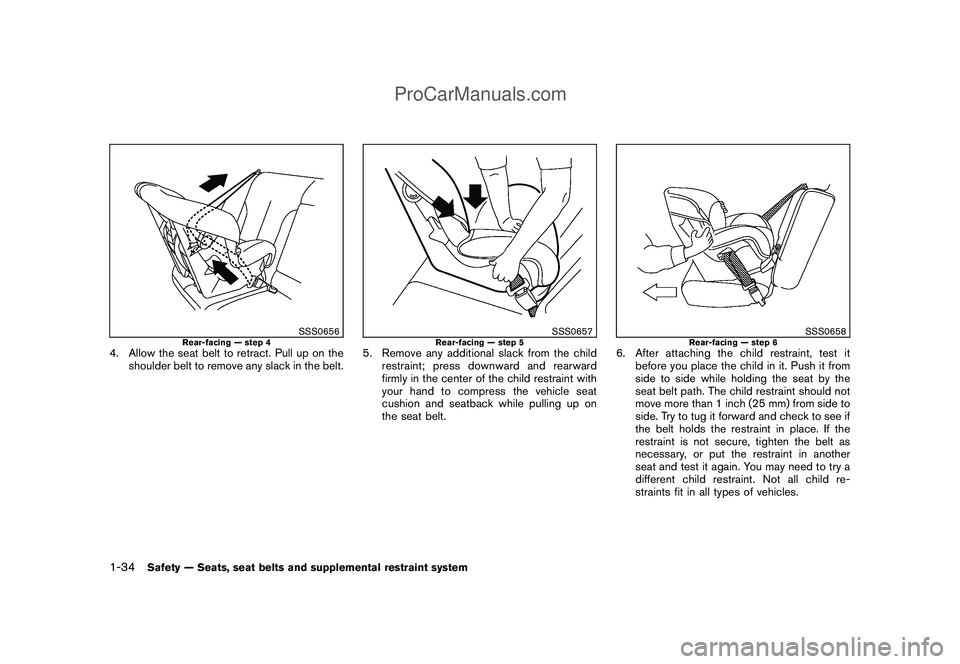2009 NISSAN CUBE belt
[x] Cancel search: beltPage 44 of 321

Black plate (42,1)
Model "Z12-D" EDITED: 2009/ 1/ 28
SSS0639
Rear-facing — step 4
4. For child restraints that are equipped with
webbing-mounted attachments, remove any
additional slack from the anchor attach-
ments. Press downward and rearward firmly
in the center of the child restraint with your
hand to compress the vehicle seat cushion
and seatback while tightening the webbing
of the anchor attachments.
SSS0650
Rear-facing — step 5
5. After attaching the child restraint, test it
before you place the child in it. Push it from
side to side while holding the seat near the
LATCH attachment path. The child restraint
should not move more than 1 inch (25 mm)
from side to side. Try to tug it forward and
check to see if the LATCH attachment holds
the restraint in place. If the restraint is not
secure, tighten the LATCH attachment as
necessary, or put the restraint in another
seat and test it again. You may need to try a
different child restraint. Not all child re-
straints fit in all types of vehicles.6. Check to make sure the child restraint is
properly secured prior to each use. If the
child restraint is loose, repeat steps 3
through 5.
1-28
Safety — Seats, seat belts and supplemental restraint system
ProCarManuals.com
Page 45 of 321

Black plate (43,1)
Model "Z12-D" EDITED: 2009/ 1/ 28
SSS0100
CHILD RESTRAINT INSTALLATION
USING THE SEAT BELTS
WARNING
.Even with the NISSAN Advanced Air
Bag System, never install a rear-
facing child restraint in the front
passenger seat. Front air bags in-
flate with great force. A rear-facing
child restraint could be struck by the
front air bag in a crash and could
seriously injure or kill your child.
.NISSAN recommends that child re-
straints be installed in the rear seat.However, if you must install a front-
facing child restraint in the front
passenger seat, move the passen-
ger seat to the rearmost position.
Also, be sure the front passenger air
bag status light is illuminated to
indicate the passenger air bag is
OFF. See “Front passenger air bag
and status light” later in this section
for details.
.The three-point seat belt in your
vehicle is equipped with an Auto-
matic Locking Retractor (ALR) which
must be used when installing a child
restraint.
.Failure to use the ALR mode will
result in the child restraint not being
properly secured. The restraint
could tip over or otherwise be un-
secured and cause injury to the child
in a sudden stop or collision.
.When using the rear center seat belt
to install a child restraint, make sure
the connector tongue and the seat
belt tongue are secured. Do not use
the seat belt with only the seat belt
tongue attached. This could result in
serious personal injury in case of an
accident or sudden stop..A child restraint with a top tether
strap should not be used in the front
passenger seat (except for Cargo
Van models) .
The instructions in this section apply to child
restraint installation using the vehicle seat belts
in the rear seat or the front passenger seat.
Safety — Seats, seat belts and supplemental restraint system
1-29
ProCarManuals.com
Page 46 of 321

Black plate (44,1)
Model "Z12-D" EDITED: 2009/ 1/ 28
SSS0640
Front-facing (front passenger seat) — step 1
Front-facingFollow these steps to install a front-facing child
restraint using the vehicle seat belt in the rear
seat (except for Cargo Van models) or in the
front passenger seat:
1. Adjust the rear seat to the upright and
rearmost position.
If you must install a child restraint in
the front seat, it should be placed in a
front-facing direction only. Move the
seat to the rearmost position. Child
restraints for infants must be used in
the rear-facing direction and therefore
must not be used in the front seat.2. Position the child restraint on the seat.
Always follow the child restraint manufac-
turer’s instructions.
The back of the child restraint should be
secured against the seatback.
If necessary, adjust the head restraint (front
passenger seat only) or remove the head
restraint/headrest to obtain the correct child
restraint fit. (See “HEAD RESTRAINTS”
earlier in this section.)
If the head restraint/headrest is removed,
store it in a secure place. Be sure to reinstall
the head restraint/headrest when the child
restraint is removed.
If the seating position does not have a
removal head restraint/headrest and it is
interfering with the proper child restraint fit,
try another seating position or a different
child restraint.
SSS0360B
Front-facing — step 3
3. Route the seat belt tongue through the child
restraint and insert it into the buckle until you
hear and feel the latch engage. Be sure to
follow the child restraint manufacturer’s
instructions for belt routing.
1-30
Safety — Seats, seat belts and supplemental restraint system
ProCarManuals.com
Page 47 of 321

Black plate (45,1)
Model "Z12-D" EDITED: 2009/ 1/ 28
SSS0651
Front-facing — step 4
4. Pull the shoulder belt until the belt is fully
extended. At this time, the seat belt retractor
is in the Automatic Locking Retractor (ALR)
mode (child restraint mode) . It reverts to the
Emergency Locking Retractor (ELR) mode
when the seat belt is fully retracted.
SSS0652
Front-facing — step 5
5. Allow the seat belt to retract. Pull up on the
shoulder belt to remove any slack in the belt.
SSS0653
Front-facing — step 6
6. Remove any additional slack from the seat
belt; press downward and rearward firmly in
the center of the child restraint with your
knee to compress the vehicle seat cushion
and seatback while pulling up on the seat
belt.
7. If the child restraint is equipped with a top
tether strap, route the top tether strap and
secure the tether strap to the tether anchor
point. (See “TOP TETHER STRAP CHILD
RESTRAINT” earlier in this section.) Do not
install child restraints that require the use of
a top tether strap to seating positions that
do not have a top tether anchor.
Safety — Seats, seat belts and supplemental restraint system
1-31
ProCarManuals.com
Page 48 of 321

Black plate (46,1)
Model "Z12-D" EDITED: 2009/ 1/ 28
SSS0641
Front-facing — step 8
8. After attaching the child restraint, test it
before you place the child in it. Push it from
side to side while holding the seat by the
seat belt path. The child restraint should not
move more than 1 inch (25 mm) from side to
side. Try to tug it forward and check to see if
the belt holds the restraint in place. If the
restraint is not secure, tighten the belt as
necessary, or put the restraint in another
seat and test it again. You may need to try a
different child restraint. Not all child re-
straints fit in all types of vehicles.9. Check that the retractor is in the ALR mode
by trying to pull more seat belt out of the
retractor. If you cannot pull any more belt
webbing out of the retractor, the retractor is
in the ALR mode.
10. Check to make sure the child restraint is
properly secured prior to each use. If the
seat belt is not locked, repeat steps 3
through 9.
SSS0481
Front-facing — step 11
11. If the child restraint is installed in the front
passenger seat, place the ignition switch in
the ON position. The front passenger air bag
status light
should illuminate. If this
light is not illuminated, see “Front passenger
air bag and status light” later in this section.
Move the child restraint to another
seating position. Have the system
checked by a NISSAN dealer.
After the child restraint is removed and the seat
belt is fully retracted, the ALR mode (child
restraint mode) is canceled.
1-32
Safety — Seats, seat belts and supplemental restraint system
ProCarManuals.com
Page 49 of 321

Black plate (47,1)
Model "Z12-D" EDITED: 2009/ 1/ 28
SSS0100
Rear-facingFollow these steps to install a rear-facing child
restraint using the vehicle seat belt in the rear
seat (except for Cargo Van models):
1.Child restraints for infants must be
used in the rear-facing direction and
therefore must not be used in the front
seat.
Adjust the rear seat to the upright and
rearmost position. Position the child restraint
on the seat. Always follow the restraint
manufacturer’s instructions.
SSS0654
Rear-facing — step 2
2. Route the seat belt tongue through the child
restraint and insert it into the buckle until you
hear and feel the latch engage. Be sure to
follow the child restraint manufacturer’s
instructions for belt routing.
SSS0655
Rear-facing — step 3
3. Pull the shoulder belt until the belt is fully
extended. At this time, the seat belt retractor
is in the Automatic Locking Retractor (ALR)
mode (child restraint mode) . It reverts to the
Emergency Locking Retractor (ELR) mode
when the seat belt is fully retracted.
Safety — Seats, seat belts and supplemental restraint system
1-33
ProCarManuals.com
Page 50 of 321

Black plate (48,1)
Model "Z12-D" EDITED: 2009/ 1/ 28
SSS0656
Rear-facing — step 4
4. Allow the seat belt to retract. Pull up on the
shoulder belt to remove any slack in the belt.
SSS0657
Rear-facing — step 5
5. Remove any additional slack from the child
restraint; press downward and rearward
firmly in the center of the child restraint with
your hand to compress the vehicle seat
cushion and seatback while pulling up on
the seat belt.
SSS0658
Rear-facing — step 6
6. After attaching the child restraint, test it
before you place the child in it. Push it from
side to side while holding the seat by the
seat belt path. The child restraint should not
move more than 1 inch (25 mm) from side to
side. Try to tug it forward and check to see if
the belt holds the restraint in place. If the
restraint is not secure, tighten the belt as
necessary, or put the restraint in another
seat and test it again. You may need to try a
different child restraint. Not all child re-
straints fit in all types of vehicles.
1-34
Safety — Seats, seat belts and supplemental restraint system
ProCarManuals.com
Page 51 of 321

Black plate (49,1)
Model "Z12-D" EDITED: 2009/ 1/ 28
7. Check that the retractor is in the ALR mode
by trying to pull more seat belt out of the
retractor. If you cannot pull any more seat
belt webbing out of the retractor, the
retractor is in the ALR mode.
8. Check to make sure that the child restraint is
properly secured prior to each use. If the
seat belt is not locked, repeat steps 3
through 7.
After the child restraint is removed and the seat
belt fully retracted, the ALR mode (child restraint
mode) is canceled.
SSS0099
PRECAUTIONS ON BOOSTER SEATS
WARNING
.Infants and small children should
always be placed in an appropriate
child restraint while riding in the
vehicle. Failure to use a child re-
straint or booster seat can result in
serious injury or death.
.Infants and small children should
never be carried on your lap. It is not
possible for even the strongest
adult to resist the forces of a severe
accident. The child could be crushedbetween the adult and parts of the
vehicle. Also, do not put the same
seat belt around both your child and
yourself.
.NISSAN recommends that the boos-
ter seat be installed in the rear seat.
According to accident statistics,
children are safer when properly
restrained in the rear seat than in
the front seat. If you must install a
booster seat in the front seat, see
“BOOSTER SEAT INSTALLATION ON
FRONT PASSENGER SEAT AND
REAR SEAT” later in this section.
.A booster seat must only be in-
stalled in a seating position that has
a lap/shoulder belt. Failure to use a
three-point type seat belt with a
booster seat can result in a serious
injury in sudden stop or collision.
.Improper use or improper installa-
tion of a booster seat can increase
the risk or severity of injury for both
the child and other occupants of the
vehicle and can lead to serious
injury or death in an accident.
.Do not use towels, books, pillows or
other items in place of a boosterBOOSTER SEATS
Safety — Seats, seat belts and supplemental restraint system
1-35
ProCarManuals.com